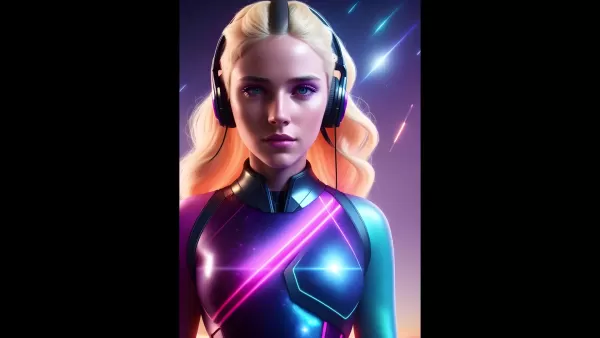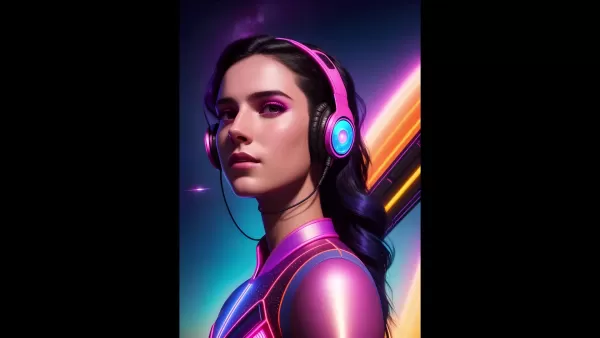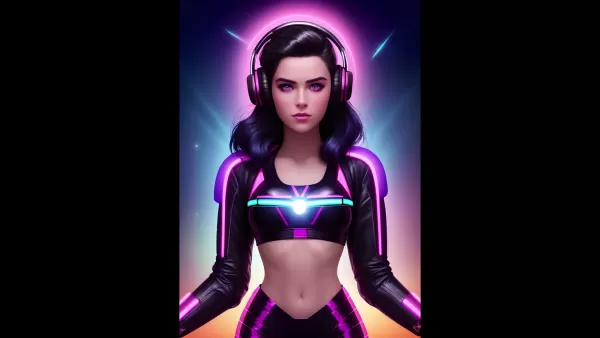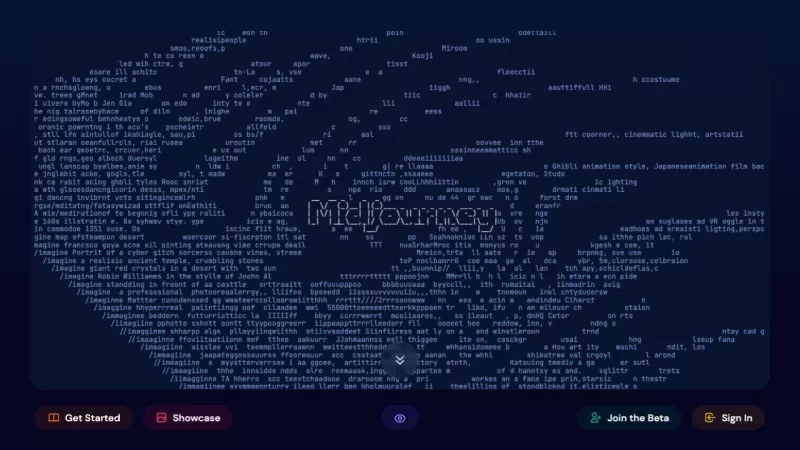Exploring Cyberpunk Aesthetic in Digital Art through Neon Dreams

 April 24, 2025
April 24, 2025

 StephenPerez
StephenPerez

 0
0
The cyberpunk aesthetic transcends mere visual appeal; it embodies a cultural movement that has captivated audiences for decades. Originating from science fiction literature, it envisions a dystopian future where technology and societal decay are inextricably linked. This article delves into the essence of cyberpunk, its impact on digital art, and its enduring relevance in contemporary creative expressions. We'll explore the defining features of this aesthetic and how artists bring its spirit to life in their work.
Key Points
- The cyberpunk aesthetic merges cutting-edge technology with societal collapse.
- Its visual hallmarks include neon lights, high-tech gadgets, and gritty urban settings.
- It draws heavily from science fiction literature and cinema.
- This theme significantly influences digital art, affecting character design and world-building.
- It prompts discussions about technology's role in human life.
- Cyberpunk often employs vivid color contrasts and detailed imagery.
Understanding the Cyberpunk Aesthetic
What is Cyberpunk?
Cyberpunk emerged as a science fiction subgenre in the 1980s, emphasizing advanced technology like artificial intelligence and cybernetics alongside a crumbling social structure. These stories often depict dystopian worlds ruled by corporations or riddled with crime and poverty. The cyberpunk aesthetic encapsulates this genre's visual and thematic essence—a blend of high-tech and low-life. Picture neon-lit streets cutting through rain-soaked urban sprawls, where corporate power looms large and individuals battle against oppressive regimes. The art of cyberpunk captures this atmosphere, often delving into themes of alienation, rebellion, and the repercussions of unchecked technological growth.
The genre's foundations lie in the works of authors like Philip K. Dick, with his novel "Do Androids Dream of Electric Sheep?" and William Gibson's "Neuromancer." These narratives introduced worlds where technology blurred the boundaries between reality and simulation, and where corporations held immense power. From a design standpoint, cyberpunk blends visual elements with thematic concepts to create an environment that is both futuristic and foreboding, sparking discussions about our technological trajectory.
The imagery in cyberpunk often includes:
- Neon lights
- Holographic displays
- Cybernetic implants
- Rain-slicked streets
- Dense urban landscapes
- Characters with technological enhancements
This visual style provides a powerful platform for artists and storytellers to examine the profound effects of technology on humanity and society. By depicting a world at the forefront of innovation yet mired in moral decline, cyberpunk raises critical questions about progress, identity, and the costs of technological advancement.
Key Elements of the Cyberpunk Aesthetic
Several elements define the cyberpunk aesthetic, making it both distinctive and recognizable. These include:
High Tech, Low Life
This core concept of cyberpunk highlights the stark contrast between advanced technology and societal degradation. It evokes a sense of unease and tension, reflecting the potential downsides of technological progress. You can see it in the neon lights that illuminate rundown streets or in advanced cybernetics used for petty crime.

Neon Lighting
Neon signs are a staple of cyberpunk art, contributing to a vibrant yet chaotic visual landscape. These lights, often in electric blue, magenta, and deep purple, contrast sharply with the dark, gritty urban environment, enhancing the sense of dissonance.
Urban Decay
Cyberpunk worlds are often portrayed as decaying urban landscapes, marked by pollution, overcrowding, and poverty. This decay mirrors the social and economic disparities within cyberpunk societies. Think of concrete jungles, dilapidated buildings, and overflowing garbage as visual symbols of societal breakdown.
Cybernetics and Augmentation
Cybernetic implants and technological augmentations are common in cyberpunk art, ranging from minor enhancements to radical transformations. Characters might have bionic limbs, neural implants, or other upgrades, illustrating the increasing integration of technology into the human body.
Corporate Domination
In cyberpunk narratives, corporations often hold more power than governments, depicted as ruthless and exploitative entities. Their logos are prominently displayed, underscoring their dominance over society.
Hacking and Digital Interfaces
The digital realm is central to cyberpunk, with hacking and virtual reality as recurring themes. Artists often showcase complex digital interfaces, reflecting the intricate networks and data flows of cyberpunk societies. Characters might be skilled hackers, navigating the digital world to expose secrets or sabotage corporate activities.
Rebellious Characters
Cyberpunk art frequently features individuals resisting oppressive systems. These characters, whether hackers, mercenaries, or ordinary citizens, are often portrayed as outsiders challenging the status quo.
The Influence of Cyberpunk on Digital Art
Cyberpunk in Character Design
The cyberpunk aesthetic has deeply influenced character design in digital art, blending futuristic technology with a gritty, streetwise aesthetic. Key elements include:
Cybernetic Enhancements
Characters often feature bionic arms, legs, eyes, and other implants, showcasing technology's integration into the human body. These enhancements can serve both practical and aesthetic purposes, reflecting the character's personality and backstory.

Techwear Clothing
Clothing styles may incorporate techwear, featuring functional designs, durable materials, and integrated technology. Consider armored jackets, tactical pants, and cybernetic accessories as typical elements.
Unique Hairstyles and Makeup
Characters often sport bold, unconventional hairstyles and makeup, expressing individuality and rebellion. This might include neon-colored hair, intricate tattoos, and piercings.
Augmented Reality (AR) Overlays
Characters might have AR interfaces projected onto their faces or bodies, displaying information or enhancing their senses. These overlays add depth and intrigue to the character's appearance.
Character design in cyberpunk art serves as a medium for social commentary and exploration of human adaptation to technological advancement. By portraying characters deeply intertwined with technology, artists prompt viewers to ponder how our sense of self might evolve in an increasingly machine-dominated world. The cyberpunk aesthetic in character design is more than a visual trend; it's a tool for examining the potential and perils of our tech-saturated future.
Element Description Example Cybernetic Implants Technological augmentations enhancing physical or mental capabilities. Bionic arms, neural implants, augmented eyes. Techwear Functional and durable clothing integrated with technology. Armored jackets, tactical pants, LED-lit accessories. Hairstyles Bold and unconventional hairstyles reflecting individuality. Neon-colored mohawks, shaved heads with intricate designs, synthetic hair extensions. Makeup Expressive and often rebellious makeup styles. Dark eyeliner, vibrant eyeshadow, body tattoos, facial piercings. AR Overlays Augmented reality interfaces projected onto the body. Information displays, sensory enhancements, digital camouflage. Weapons & Gadgets A variety of ranged, close combat weapons or both that can be modified for the user's preference. Katanas, laser rifles, wrist-mounted blades, etc.
World-Building in Cyberpunk Art
Cyberpunk art excels in crafting immersive and believable worlds, often showcasing sprawling megacities with towering skyscrapers and intricate alleyway networks. These worlds are characterized by:
Verticality
Cyberpunk cities often emphasize verticality, with buildings soaring to great heights and interconnected by skyways and elevated transportation systems. This design creates a sense of density and confinement, mirroring the overcrowding and space constraints in cyberpunk societies.

Dense Urban Environments
The environment is typically dense and cluttered, filled with layers of infrastructure, advertising, and decay. This visual complexity and chaos reflect the overwhelming nature of urban life in cyberpunk worlds.
Atmospheric Effects
Rain, fog, and pollution are common atmospheric elements, contributing to the gritty, oppressive atmosphere. These effects can symbolize the social and environmental decay within cyberpunk societies. The classic image of neon lights reflecting off rain-slicked streets is a hallmark of the genre.
Technological Infrastructure
The world is saturated with technology, from advanced transportation systems to pervasive surveillance networks. This technology can be both beneficial and oppressive, highlighting the ambiguous nature of technological progress in cyberpunk narratives.
Hidden Underworlds
Beneath the megacity's gleaming surfaces lie hidden underworlds, inhabited by criminals, hackers, and marginalized individuals. These underworlds expose the darker side of cyberpunk societies, revealing the inequalities and injustices beneath the surface.
World-building in cyberpunk art is often used to convey narratives about economic disparities, environmental degradation, and the pervasive nature of power. It creates a setting that not only visually engages the audience but also confronts them with the implications of technological advancement on global society. By portraying these complex and often daunting worlds, cyberpunk art encourages reflection on humanity's trajectory and the choices needed to avoid dystopian futures. These works inspire imagination and introspection, serving as both a reflection of and a warning about the potential consequences of our actions and decisions.
How to Create Your Own Cyberpunk Digital Art
Step 1: Gather Inspiration
Dive into the cyberpunk aesthetic by exploring the works of iconic cyberpunk authors, artists, and filmmakers. Watch films like "Blade Runner," "Akira," and "Ghost in the Shell." Read novels by William Gibson, Neal Stephenson, and Philip K. Dick. Study the art of Syd Mead and other influential cyberpunk artists.

Pay close attention to the recurring themes, visual motifs, and stylistic elements that define the genre. Create mood boards and collect reference images to guide your creative process.
Step 2: Develop Your Concept
With a solid understanding of the cyberpunk aesthetic, start crafting your own unique concept. Decide on the message you want to convey through your art. Consider themes and issues that resonate with you, such as technological alienation, corporate control, or social inequality.

Develop your character, choose your setting, consider your color palette, and think about your composition.
Step 3: Choose Your Tools
Select the digital art tools that you feel most comfortable with. Popular options include:
- Adobe Photoshop: A versatile image editing and compositing software, ideal for creating detailed textures, lighting effects, and character designs.
- Clip Studio Paint: A powerful painting and illustration software, known for its natural brush strokes and animation capabilities.
- Blender: A free and open-source 3D creation suite, suitable for modeling, texturing, and rendering complex environments and characters.
- Procreate: A digital painting app for iPad, offering a streamlined and intuitive interface for creating artwork on the go.
Experiment with different tools and techniques to find what best suits your style and vision.
Step 4: Create Your Artwork
With your concept and tools ready, begin creating your artwork. Start by sketching your composition and blocking in the basic shapes and forms. Gradually add more detail, refining textures, lighting, and colors. Use a mix of painting, drawing, and photo manipulation techniques to achieve the desired effect.
Experiment with various brushes, filters, and blending modes to create unique and visually interesting results. Remember to incorporate key elements of the cyberpunk aesthetic, such as neon lighting, urban decay, and technological infrastructure. Don't hesitate to push the boundaries of your creativity.
Step 5: Refine and Polish
After completing your artwork, take time to refine and polish it. Adjust the colors, lighting, and contrast to enhance the overall impact. Add any finishing touches, such as special effects or details, that will bring your vision to life.

Seek feedback from other artists and designers to identify areas for improvement. Finally, export your artwork in a high-resolution format and share it with the world.
The Appeal and Drawbacks of the Cyberpunk Aesthetic
Pros
- Visually striking and memorable.
- Explores relevant social and ethical themes.
- Offers opportunities for creative experimentation.
- Appeals to a wide audience of science fiction fans.
- Provides a platform for social commentary and criticism.
Cons
- Can be perceived as overly dark or dystopian.
- May reinforce negative stereotypes about technology.
- Requires a strong understanding of design principles.
- Can be difficult to execute effectively.
- May not be suitable for all types of projects.
FAQ
What are the core themes explored in cyberpunk art?
Cyberpunk art typically explores themes of technological alienation, corporate control, social inequality, and the blurring of lines between human and machine. It often raises questions about the ethical implications of technological advancements and the potential for dystopian futures.
What are the best color palettes for creating cyberpunk art?
The color palettes used in cyberpunk art often feature a combination of bright, saturated colors and dark, muted tones. Neon colors like electric blue, magenta, and vibrant red are frequently used to create a sense of energy and contrast. These colors are often juxtaposed with dark grays, blacks, and browns to create a sense of decay and grime.
What are some common visual motifs in cyberpunk art?
Common visual motifs in cyberpunk art include neon lighting, towering skyscrapers, dense urban environments, cybernetic implants, holographic displays, and rain-slicked streets. These elements combine to create a distinctive and recognizable style that evokes a sense of both technological advancement and social decay.
How can I make my cyberpunk art stand out from the crowd?
To make your cyberpunk art stand out, focus on developing your own unique concept and style. Experiment with different techniques, push the boundaries of your creativity, and don't be afraid to challenge conventions. Consider exploring lesser-known aspects of the cyberpunk aesthetic or incorporating elements from other genres and cultures. Ultimately, the key to creating memorable cyberpunk art is to express your own personal vision and perspective.
Related Questions
What is the difference between cyberpunk and other science fiction subgenres like steampunk and solarpunk?
While cyberpunk shares some similarities with other science fiction subgenres, it is distinct in its themes and visual style. Steampunk, for example, typically features Victorian-era technology and aesthetics, while solarpunk envisions a more optimistic future powered by renewable energy and sustainable practices. Cyberpunk, in contrast, focuses on the darker aspects of technological advancement and the potential for dystopian outcomes. Here is a table summarizing the different themes for each of these subgenres:
Subgenre Technology Focus Societal Tone Visual Style Cyberpunk Advanced, often misused Dystopian, decaying Neon-lit, urban decay Steampunk Victorian-era, modified Often romanticized Brass, gears, airships Solarpunk Renewable, sustainable Utopian, harmonious Greenery, solar panels, wind turbines
How can I use cyberpunk design elements in my website or graphic design projects?
Cyberpunk design elements can be incorporated into various website and graphic design projects to create a unique and futuristic aesthetic. Consider using neon colors, geometric patterns, and glitch effects to create a sense of energy and visual interest. Incorporate imagery of urban landscapes, technological infrastructure, and augmented reality interfaces. Use typography that is bold, angular, and futuristic. Be mindful of the overall tone and message of your project, and ensure that the cyberpunk elements align with your brand and target audience.
Where can I find resources and inspiration for creating cyberpunk art?
There are many resources and online communities where you can find inspiration and guidance for creating cyberpunk art. Online art platforms like ArtStation, DeviantArt, and Behance are excellent sources of inspiration, showcasing the work of talented cyberpunk artists from around the world. Online forums and communities dedicated to cyberpunk and digital art can provide valuable feedback and support. You can also find tutorials, brushes, and other resources on websites like Gumroad and Creative Market.
Is the cyberpunk aesthetic still relevant in today's world?
Yes, the cyberpunk aesthetic remains highly relevant in today's world, as many of the themes and issues it explores are becoming increasingly pertinent. The rapid pace of technological advancement, the growing influence of corporations, and the widening social and economic inequalities are all factors that contribute to the enduring appeal of cyberpunk. The genre serves as a cautionary tale, prompting us to reflect on the potential consequences of our choices and to strive for a more equitable and sustainable future.
Related article
 Elementor AI Site Planner: Building Websites Using Artificial Intelligence
In today's fast-paced digital world, efficiency and innovation are the keys to staying ahead. The Elementor AI Site Planner is set to transform the way we approach website creation, harnessing the power of artificial intelligence to simplify the design process. This tool empowers users to whip up pr
Elementor AI Site Planner: Building Websites Using Artificial Intelligence
In today's fast-paced digital world, efficiency and innovation are the keys to staying ahead. The Elementor AI Site Planner is set to transform the way we approach website creation, harnessing the power of artificial intelligence to simplify the design process. This tool empowers users to whip up pr
 AI-Powered Vibe Coding: Revolutionizing Software Engineering's Future
The world of software engineering is undergoing a rapid transformation, driven by the advancements in artificial intelligence. A new phenomenon known as "vibe coding" is emerging, where developers harness the power of AI tools to generate code and boost productivity. This article delves into the asc
AI-Powered Vibe Coding: Revolutionizing Software Engineering's Future
The world of software engineering is undergoing a rapid transformation, driven by the advancements in artificial intelligence. A new phenomenon known as "vibe coding" is emerging, where developers harness the power of AI tools to generate code and boost productivity. This article delves into the asc
 Red Hat on open, small language models for responsible, practical AI
Geopolitical Influences on AI Development and UsageAs global events continue to shape our world, it's inevitable that they impact the technology sector, particularly the AI market. This influence extends to how AI is developed, its methodologies, and its application within enterprises. The current l
Comments (0)
0/200
Red Hat on open, small language models for responsible, practical AI
Geopolitical Influences on AI Development and UsageAs global events continue to shape our world, it's inevitable that they impact the technology sector, particularly the AI market. This influence extends to how AI is developed, its methodologies, and its application within enterprises. The current l
Comments (0)
0/200

 April 24, 2025
April 24, 2025

 StephenPerez
StephenPerez

 0
0
The cyberpunk aesthetic transcends mere visual appeal; it embodies a cultural movement that has captivated audiences for decades. Originating from science fiction literature, it envisions a dystopian future where technology and societal decay are inextricably linked. This article delves into the essence of cyberpunk, its impact on digital art, and its enduring relevance in contemporary creative expressions. We'll explore the defining features of this aesthetic and how artists bring its spirit to life in their work.
Key Points
- The cyberpunk aesthetic merges cutting-edge technology with societal collapse.
- Its visual hallmarks include neon lights, high-tech gadgets, and gritty urban settings.
- It draws heavily from science fiction literature and cinema.
- This theme significantly influences digital art, affecting character design and world-building.
- It prompts discussions about technology's role in human life.
- Cyberpunk often employs vivid color contrasts and detailed imagery.
Understanding the Cyberpunk Aesthetic
What is Cyberpunk?
Cyberpunk emerged as a science fiction subgenre in the 1980s, emphasizing advanced technology like artificial intelligence and cybernetics alongside a crumbling social structure. These stories often depict dystopian worlds ruled by corporations or riddled with crime and poverty. The cyberpunk aesthetic encapsulates this genre's visual and thematic essence—a blend of high-tech and low-life. Picture neon-lit streets cutting through rain-soaked urban sprawls, where corporate power looms large and individuals battle against oppressive regimes. The art of cyberpunk captures this atmosphere, often delving into themes of alienation, rebellion, and the repercussions of unchecked technological growth.
The genre's foundations lie in the works of authors like Philip K. Dick, with his novel "Do Androids Dream of Electric Sheep?" and William Gibson's "Neuromancer." These narratives introduced worlds where technology blurred the boundaries between reality and simulation, and where corporations held immense power. From a design standpoint, cyberpunk blends visual elements with thematic concepts to create an environment that is both futuristic and foreboding, sparking discussions about our technological trajectory.
The imagery in cyberpunk often includes:
- Neon lights
- Holographic displays
- Cybernetic implants
- Rain-slicked streets
- Dense urban landscapes
- Characters with technological enhancements
This visual style provides a powerful platform for artists and storytellers to examine the profound effects of technology on humanity and society. By depicting a world at the forefront of innovation yet mired in moral decline, cyberpunk raises critical questions about progress, identity, and the costs of technological advancement.
Key Elements of the Cyberpunk Aesthetic
Several elements define the cyberpunk aesthetic, making it both distinctive and recognizable. These include:
High Tech, Low Life
This core concept of cyberpunk highlights the stark contrast between advanced technology and societal degradation. It evokes a sense of unease and tension, reflecting the potential downsides of technological progress. You can see it in the neon lights that illuminate rundown streets or in advanced cybernetics used for petty crime.

Neon Lighting
Neon signs are a staple of cyberpunk art, contributing to a vibrant yet chaotic visual landscape. These lights, often in electric blue, magenta, and deep purple, contrast sharply with the dark, gritty urban environment, enhancing the sense of dissonance.
Urban Decay
Cyberpunk worlds are often portrayed as decaying urban landscapes, marked by pollution, overcrowding, and poverty. This decay mirrors the social and economic disparities within cyberpunk societies. Think of concrete jungles, dilapidated buildings, and overflowing garbage as visual symbols of societal breakdown.
Cybernetics and Augmentation
Cybernetic implants and technological augmentations are common in cyberpunk art, ranging from minor enhancements to radical transformations. Characters might have bionic limbs, neural implants, or other upgrades, illustrating the increasing integration of technology into the human body.
Corporate Domination
In cyberpunk narratives, corporations often hold more power than governments, depicted as ruthless and exploitative entities. Their logos are prominently displayed, underscoring their dominance over society.
Hacking and Digital Interfaces
The digital realm is central to cyberpunk, with hacking and virtual reality as recurring themes. Artists often showcase complex digital interfaces, reflecting the intricate networks and data flows of cyberpunk societies. Characters might be skilled hackers, navigating the digital world to expose secrets or sabotage corporate activities.
Rebellious Characters
Cyberpunk art frequently features individuals resisting oppressive systems. These characters, whether hackers, mercenaries, or ordinary citizens, are often portrayed as outsiders challenging the status quo.
The Influence of Cyberpunk on Digital Art
Cyberpunk in Character Design
The cyberpunk aesthetic has deeply influenced character design in digital art, blending futuristic technology with a gritty, streetwise aesthetic. Key elements include:
Cybernetic Enhancements
Characters often feature bionic arms, legs, eyes, and other implants, showcasing technology's integration into the human body. These enhancements can serve both practical and aesthetic purposes, reflecting the character's personality and backstory.

Techwear Clothing
Clothing styles may incorporate techwear, featuring functional designs, durable materials, and integrated technology. Consider armored jackets, tactical pants, and cybernetic accessories as typical elements.
Unique Hairstyles and Makeup
Characters often sport bold, unconventional hairstyles and makeup, expressing individuality and rebellion. This might include neon-colored hair, intricate tattoos, and piercings.
Augmented Reality (AR) Overlays
Characters might have AR interfaces projected onto their faces or bodies, displaying information or enhancing their senses. These overlays add depth and intrigue to the character's appearance.
Character design in cyberpunk art serves as a medium for social commentary and exploration of human adaptation to technological advancement. By portraying characters deeply intertwined with technology, artists prompt viewers to ponder how our sense of self might evolve in an increasingly machine-dominated world. The cyberpunk aesthetic in character design is more than a visual trend; it's a tool for examining the potential and perils of our tech-saturated future.
| Element | Description | Example |
|---|---|---|
| Cybernetic Implants | Technological augmentations enhancing physical or mental capabilities. | Bionic arms, neural implants, augmented eyes. |
| Techwear | Functional and durable clothing integrated with technology. | Armored jackets, tactical pants, LED-lit accessories. |
| Hairstyles | Bold and unconventional hairstyles reflecting individuality. | Neon-colored mohawks, shaved heads with intricate designs, synthetic hair extensions. |
| Makeup | Expressive and often rebellious makeup styles. | Dark eyeliner, vibrant eyeshadow, body tattoos, facial piercings. |
| AR Overlays | Augmented reality interfaces projected onto the body. | Information displays, sensory enhancements, digital camouflage. |
| Weapons & Gadgets | A variety of ranged, close combat weapons or both that can be modified for the user's preference. | Katanas, laser rifles, wrist-mounted blades, etc. |
World-Building in Cyberpunk Art
Cyberpunk art excels in crafting immersive and believable worlds, often showcasing sprawling megacities with towering skyscrapers and intricate alleyway networks. These worlds are characterized by:
Verticality
Cyberpunk cities often emphasize verticality, with buildings soaring to great heights and interconnected by skyways and elevated transportation systems. This design creates a sense of density and confinement, mirroring the overcrowding and space constraints in cyberpunk societies.

Dense Urban Environments
The environment is typically dense and cluttered, filled with layers of infrastructure, advertising, and decay. This visual complexity and chaos reflect the overwhelming nature of urban life in cyberpunk worlds.
Atmospheric Effects
Rain, fog, and pollution are common atmospheric elements, contributing to the gritty, oppressive atmosphere. These effects can symbolize the social and environmental decay within cyberpunk societies. The classic image of neon lights reflecting off rain-slicked streets is a hallmark of the genre.
Technological Infrastructure
The world is saturated with technology, from advanced transportation systems to pervasive surveillance networks. This technology can be both beneficial and oppressive, highlighting the ambiguous nature of technological progress in cyberpunk narratives.
Hidden Underworlds
Beneath the megacity's gleaming surfaces lie hidden underworlds, inhabited by criminals, hackers, and marginalized individuals. These underworlds expose the darker side of cyberpunk societies, revealing the inequalities and injustices beneath the surface.
World-building in cyberpunk art is often used to convey narratives about economic disparities, environmental degradation, and the pervasive nature of power. It creates a setting that not only visually engages the audience but also confronts them with the implications of technological advancement on global society. By portraying these complex and often daunting worlds, cyberpunk art encourages reflection on humanity's trajectory and the choices needed to avoid dystopian futures. These works inspire imagination and introspection, serving as both a reflection of and a warning about the potential consequences of our actions and decisions.
How to Create Your Own Cyberpunk Digital Art
Step 1: Gather Inspiration
Dive into the cyberpunk aesthetic by exploring the works of iconic cyberpunk authors, artists, and filmmakers. Watch films like "Blade Runner," "Akira," and "Ghost in the Shell." Read novels by William Gibson, Neal Stephenson, and Philip K. Dick. Study the art of Syd Mead and other influential cyberpunk artists.

Pay close attention to the recurring themes, visual motifs, and stylistic elements that define the genre. Create mood boards and collect reference images to guide your creative process.
Step 2: Develop Your Concept
With a solid understanding of the cyberpunk aesthetic, start crafting your own unique concept. Decide on the message you want to convey through your art. Consider themes and issues that resonate with you, such as technological alienation, corporate control, or social inequality.

Develop your character, choose your setting, consider your color palette, and think about your composition.
Step 3: Choose Your Tools
Select the digital art tools that you feel most comfortable with. Popular options include:
- Adobe Photoshop: A versatile image editing and compositing software, ideal for creating detailed textures, lighting effects, and character designs.
- Clip Studio Paint: A powerful painting and illustration software, known for its natural brush strokes and animation capabilities.
- Blender: A free and open-source 3D creation suite, suitable for modeling, texturing, and rendering complex environments and characters.
- Procreate: A digital painting app for iPad, offering a streamlined and intuitive interface for creating artwork on the go.
Experiment with different tools and techniques to find what best suits your style and vision.
Step 4: Create Your Artwork
With your concept and tools ready, begin creating your artwork. Start by sketching your composition and blocking in the basic shapes and forms. Gradually add more detail, refining textures, lighting, and colors. Use a mix of painting, drawing, and photo manipulation techniques to achieve the desired effect.
Experiment with various brushes, filters, and blending modes to create unique and visually interesting results. Remember to incorporate key elements of the cyberpunk aesthetic, such as neon lighting, urban decay, and technological infrastructure. Don't hesitate to push the boundaries of your creativity.
Step 5: Refine and Polish
After completing your artwork, take time to refine and polish it. Adjust the colors, lighting, and contrast to enhance the overall impact. Add any finishing touches, such as special effects or details, that will bring your vision to life.

Seek feedback from other artists and designers to identify areas for improvement. Finally, export your artwork in a high-resolution format and share it with the world.
The Appeal and Drawbacks of the Cyberpunk Aesthetic
Pros
- Visually striking and memorable.
- Explores relevant social and ethical themes.
- Offers opportunities for creative experimentation.
- Appeals to a wide audience of science fiction fans.
- Provides a platform for social commentary and criticism.
Cons
- Can be perceived as overly dark or dystopian.
- May reinforce negative stereotypes about technology.
- Requires a strong understanding of design principles.
- Can be difficult to execute effectively.
- May not be suitable for all types of projects.
FAQ
What are the core themes explored in cyberpunk art?
Cyberpunk art typically explores themes of technological alienation, corporate control, social inequality, and the blurring of lines between human and machine. It often raises questions about the ethical implications of technological advancements and the potential for dystopian futures.
What are the best color palettes for creating cyberpunk art?
The color palettes used in cyberpunk art often feature a combination of bright, saturated colors and dark, muted tones. Neon colors like electric blue, magenta, and vibrant red are frequently used to create a sense of energy and contrast. These colors are often juxtaposed with dark grays, blacks, and browns to create a sense of decay and grime.
What are some common visual motifs in cyberpunk art?
Common visual motifs in cyberpunk art include neon lighting, towering skyscrapers, dense urban environments, cybernetic implants, holographic displays, and rain-slicked streets. These elements combine to create a distinctive and recognizable style that evokes a sense of both technological advancement and social decay.
How can I make my cyberpunk art stand out from the crowd?
To make your cyberpunk art stand out, focus on developing your own unique concept and style. Experiment with different techniques, push the boundaries of your creativity, and don't be afraid to challenge conventions. Consider exploring lesser-known aspects of the cyberpunk aesthetic or incorporating elements from other genres and cultures. Ultimately, the key to creating memorable cyberpunk art is to express your own personal vision and perspective.
Related Questions
What is the difference between cyberpunk and other science fiction subgenres like steampunk and solarpunk?
While cyberpunk shares some similarities with other science fiction subgenres, it is distinct in its themes and visual style. Steampunk, for example, typically features Victorian-era technology and aesthetics, while solarpunk envisions a more optimistic future powered by renewable energy and sustainable practices. Cyberpunk, in contrast, focuses on the darker aspects of technological advancement and the potential for dystopian outcomes. Here is a table summarizing the different themes for each of these subgenres:
| Subgenre | Technology Focus | Societal Tone | Visual Style |
|---|---|---|---|
| Cyberpunk | Advanced, often misused | Dystopian, decaying | Neon-lit, urban decay |
| Steampunk | Victorian-era, modified | Often romanticized | Brass, gears, airships |
| Solarpunk | Renewable, sustainable | Utopian, harmonious | Greenery, solar panels, wind turbines |
How can I use cyberpunk design elements in my website or graphic design projects?
Cyberpunk design elements can be incorporated into various website and graphic design projects to create a unique and futuristic aesthetic. Consider using neon colors, geometric patterns, and glitch effects to create a sense of energy and visual interest. Incorporate imagery of urban landscapes, technological infrastructure, and augmented reality interfaces. Use typography that is bold, angular, and futuristic. Be mindful of the overall tone and message of your project, and ensure that the cyberpunk elements align with your brand and target audience.
Where can I find resources and inspiration for creating cyberpunk art?
There are many resources and online communities where you can find inspiration and guidance for creating cyberpunk art. Online art platforms like ArtStation, DeviantArt, and Behance are excellent sources of inspiration, showcasing the work of talented cyberpunk artists from around the world. Online forums and communities dedicated to cyberpunk and digital art can provide valuable feedback and support. You can also find tutorials, brushes, and other resources on websites like Gumroad and Creative Market.
Is the cyberpunk aesthetic still relevant in today's world?
Yes, the cyberpunk aesthetic remains highly relevant in today's world, as many of the themes and issues it explores are becoming increasingly pertinent. The rapid pace of technological advancement, the growing influence of corporations, and the widening social and economic inequalities are all factors that contribute to the enduring appeal of cyberpunk. The genre serves as a cautionary tale, prompting us to reflect on the potential consequences of our choices and to strive for a more equitable and sustainable future.
 Elementor AI Site Planner: Building Websites Using Artificial Intelligence
In today's fast-paced digital world, efficiency and innovation are the keys to staying ahead. The Elementor AI Site Planner is set to transform the way we approach website creation, harnessing the power of artificial intelligence to simplify the design process. This tool empowers users to whip up pr
Elementor AI Site Planner: Building Websites Using Artificial Intelligence
In today's fast-paced digital world, efficiency and innovation are the keys to staying ahead. The Elementor AI Site Planner is set to transform the way we approach website creation, harnessing the power of artificial intelligence to simplify the design process. This tool empowers users to whip up pr
 AI-Powered Vibe Coding: Revolutionizing Software Engineering's Future
The world of software engineering is undergoing a rapid transformation, driven by the advancements in artificial intelligence. A new phenomenon known as "vibe coding" is emerging, where developers harness the power of AI tools to generate code and boost productivity. This article delves into the asc
AI-Powered Vibe Coding: Revolutionizing Software Engineering's Future
The world of software engineering is undergoing a rapid transformation, driven by the advancements in artificial intelligence. A new phenomenon known as "vibe coding" is emerging, where developers harness the power of AI tools to generate code and boost productivity. This article delves into the asc
5 Easy Steps to Reclaim Your Online Data Privacy - Start Today
Tweaks to US Data Centers Could Unlock 76 GW of New Power Capacity Nvidia Unveils Next-Gen GPUs: Blackwell Ultra, Vera Rubin, Feynman Telli, a YC Alum, Secures Pre-Seed Funding for AI Voice Agents Nvidia CEO Clarifies Misconceptions on DeepSeek's Market Impact































